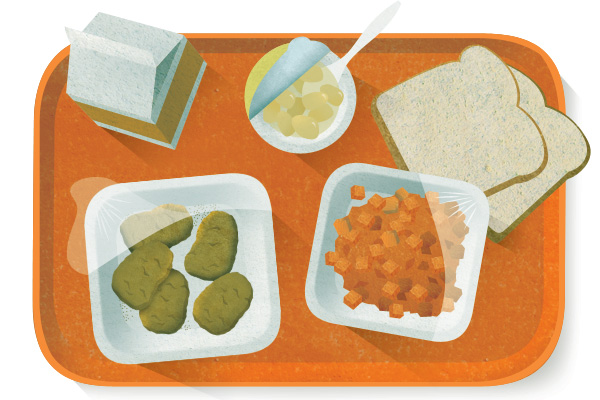 story by liz pachecoPhiladelphia high school student Seth Brown is frank about it: He started skipping lunch more and more this past year. “The rate has increased this year,” says the 18-year-old rising senior at West Philadelphia’s Parkway West High School, “because my English class is above the kitchen.”
story by liz pachecoPhiladelphia high school student Seth Brown is frank about it: He started skipping lunch more and more this past year. “The rate has increased this year,” says the 18-year-old rising senior at West Philadelphia’s Parkway West High School, “because my English class is above the kitchen.”
According to Brown, the smells were less than appetizing. The days Brown did eat lunch in the cafeteria weren’t much better.
“My classmates and I either threw out the lunches because they didn’t look good, or we didn’t trust what was prepared,” he says. “That happened on several occasions.”
While Brown says the full-service cafeteria will serve homemade dishes, like lasagna, the menu also offers pre-packaged hoagies, salads and prepared hot meals—often featuring poorly cooked hamburgers, chicken patties and milk, sometimes past its drink-by date.
So, Brown has decided to take a stand against substandard school lunches outside the cafeteria. He is a member of the Philadelphia Urban Food and Fitness Alliance (PUFFA), a youth advocacy organization that’s part of a national movement to shape how children are fed and to provide safe places for exercise. PUFFA, supported with a three-year grant from the W.K. Kellogg Foundation, works with youth leadership and advocacy group Southeast Philadelphia Collaborative to bring together high school students from West and South Philadelphia interested in healthy living.
PUFFA joins other organizations and individuals in Philadelphia, students and adults, working for fresher, healthier and more appetizing school lunches. Their efforts haven’t gone unnoticed, and the School District of Philadelphia is facilitating changes, like supporting the Farm to School program (which brings farm-fresh food to school cafeterias). But obstacles still abound. The district is making budget cuts, and improved school lunches are on the chopping block. These cuts would come at a high price in Philadelphia; poverty is prevalent and often school lunch is the only opportunity a child has for a fresh, nutritious meal all day.
The Satellite Scare
“Naturally, I’m pro-health and pro-advocacy,” says Brown about his decision to join PUFFA. “I liked what PUFFA was all about.”
Brown says he heard about the organization through a friend, which, according to PUFFA Program Director Diane-Louise Wormley, is the way most students get involved.
The program, which initially began with a pilot group of just a few students, now has 20 to 35 high school students meeting monthly. The students, who refer to themselves as part of Students Advocating for Lifestyle Transformations (SALT), spend the two-hour meetings cooking healthy food, playing Wii (for exercise) and developing peer-education skills, like writing text messages that promote a healthy and active lifestyle, or practicing video camera skills for a public service announcement they plan to record. Past meetings have included lessons on making sushi, shepherd’s pie and oven-baked chicken.
“The idea is that they select food they like anyway and learn… how to make it healthier,” says Wormley. “We’re not trying to make them gurus. That’s not likely for 15- and 16-year-olds.”
The students have opportunities to attend conferences, like the annual W.K. Kellogg Foundation Conference and the Rooted in Community Conference, a youth leadership summit hosted by the Urban Nutrition Initiative in Philadelphia at the end of July. There is also a summer internship program during which students spend time at WHYY learning photo, video and audio skills to use in their advocacy. Aside from mentors, the program is almost all student-led, a format, Wormely explains, that allows the students to try new things while building self confidence and leadership skills in a fun way.
“PUFFA is really about advocacy for systems and policy change,” says Wormley, and “anticipating there will be elements where our youth want to stand up and speak out.”
For instance, when members of PUFFA heard that the School District of Philadelphia was considering a major change to the school lunch program, Brown was asked to speak for the students at a meeting of the School Reform Commission (SRC), the school district’s five-person governing board.
The proposed change, which was never publicly announced to administration, students or parents, would convert 26 elementary and middle school full-service kitchens into pre-plated “satellite” meal service for September 2011. These “satellite” meals would use the same foods and follow the same nutritional guidelines as full-service kitchens, but would be prepared in food factories in Brooklyn, N.Y., or Wilkes-Barre, Pa., then shipped to Philadelphia schools where they would be reheated or served cold.
Though GRID was denied its request for a sample meal from Illinois-based Preferred Meal Systems, according to numerous reports, the meals resemble airplane food: individually portioned and sealed with a cellophane cover. Even the peanut butter and jelly sandwiches are factory-made, prepared and packaged in a way that resembles warm ice cream sandwiches. (To see what satellite lunches are all about, visit fedupwithschoollunch.blogspot.com, a blog written by a teacher who ate them every day for a year.)
According to a June Inquirer report, the conversion is projected to save the School District $2.3 million toward closing its $629 million budget gap. “It was a very difficult decision, but we had to cut a little bit everywhere to be able to come up with enough dollars to balance our budget,” says Fernando Gallard, spokesperson for the School District. He assures that the decision is purely budget-based and is “not reflective of the commitment of the school district regarding nutrition.”
“We know the pre-plated stuff isn’t as appealing to kids, but we know that’s the only option in some schools,” says Kathy Fisher, Family Economic Security Associate at child advocacy group Public Citizens for Children and Youth (PCCY). But Fisher isn’t in support of the conversion to pre-plated. If the less-appealing pre-plated meals are served, fewer children will likely be eating them. “For us, we just really want to see that low-income [children] are fed and fed stuff they want to eat,” she says.
The Numbers Game
Appealing to kids is a huge part of the school lunch business. The more students who purchase school lunch, the more federal reimbursement the Division of Food Services and the school district receive. Without that funding, providing appealing meals to students can be a challenge. Not surprisingly, the switch to pre-plated meals is expected to decrease participation rates. Of the district’s 315 meal sites, 70 percent already don’t have full-service kitchens.
The school district and city’s health department are currently conducting a study funded by the Centers for Disease Control that will compare pre-plated meals with those of full-service kitchens. Part of the study will assess discarded and rejected meals. Child and nutrition advocacy organizations are asking the school district to wait until the study is completed in December 2011 before making a final decision on the conversion to satellite meals. Their request came in a joint statement to the SRC, which outlined the ramifications of closing the full-service kitchens: negative impacts on student health, wasted kitchen equipment, firing of cafeteria managers and staff, undercutting successful health and nutrition efforts, and reduction of school lunch revenue for the district.
The statement was presented by PCCY, PUFFA, Community Legal Services, Center for Hunger-Free Communities and the Greater Philadelphia Coalition Against Hunger at a special July 1 meeting of the SRC. Arlene Ackerman, the school district’s CEO and superintendent, and SRC members were in attendance.
For Seth Brown, speaking at the SRC meeting was an important lesson in school food politics.
“The experience opened my eyes of how serious the school board is, how serious this issue is,” he says. Even over the phone, Brown is articulate and polite, confident and comfortable in expressing his opinion. It’s easy to see why his peers immediately chose him as their spokesperson.
“My peers and I,” he reads from a draft of his speech over the phone, “we’re tired of receiving the pink cheeseburgers, the rotten milks and the pink chicken patties. We’re tired of the rotten vegetables.”
A video clip from the meeting shows Brown dressed in a shirt and tie, a bit too tall for the microphone. Although the audio is poor, it is clear that Brown is invested in what he’s speaking about; he repeatedly makes eye contact, not intimidated by his adult audience.
“The full service kitchens would make the students feel special, respected and appreciated,” he says, again reading from the draft. “No kids should be disrespected during lunch and no kid should be hungry after lunch. They should be satisfied with what they take in.”
For Each Step Forward…
In a school district where much effort is being put into improving school lunch, the conversion to pre-plated meals would be a big obstacle for programs like Farm to School. Here in Philadelphia, Farm to School is a collaborative effort. Fair Food, the Food Trust, Common Market and, most recently, PUFFA combine resources to bring local, farm-fresh produce to the city’s school cafeterias and better healthy living education to students.
The program is part of a larger, national network that’s almost 10 years old and is funded by the meal budgets of the individual school districts, not grants. In Philadelphia, Farm to School started in 2009 with five schools. Last year, it brought 60,000 pounds of produce to 25 schools. While the program will not be extended to additional schools this fall (due to a lack of funding), there will be a bigger push to take Farm to School beyond the cafeteria and make students more aware about the foods they’re eating.
“Reaching that many students is very challenging, making them aware of what’s going on and why it’s important,” says Deb Bentzel, the Farm to Institution Program manager at Fair Food. It can be even more difficult than getting the farm produce in the first place, she adds.
With the help of Common Market, a Philadelphia wholesale distributor of local foods, integrating farm produce into regular menus has been made easier. And even more so, since Common Market recently received a $1.1 million grant from the W.K. Kellogg Foundation to purchase equipment and retrofit their warehouse for upcoming food safety regulation changes.
For schools with full-service kitchens, Farm to School allows cafeteria staff to create dishes specific to the produce.
“With the satellite meal program, it becomes a little more complicated,” says Alyssa Moles, Farm to School program coordinator at the Food Trust. “The equipment is no longer in the kitchen to cook fresh food, and sometimes the manager in charge of the satellite meal may not have the certification to prepare fresh foods.”
But there are other options. A Farm to School pilot program was conducted last year at three pre-plated schools. Salad bars with local produce were offered and Moles says they were well received.
Change in Philadelphia “has been moving more like a tortoise than a hare,” she says. With such a huge budget shortfall, changes are happening slowly and deliberately, to ensure they’re sustainable.
But compared with other school districts of similar size, Moles says that Philadelphia is considered advanced in its work and approach to creating better eating options for its students.
Fisher, though, isn’t as optimistic.
“We know the district is in a tight spot now. They’re trimming everywhere they can,” She says. “[But] it’s like a step backward for the efforts they’ve been putting into getting fresher foods.”
To to involved with PUFFA visit https://bhcusa.serverdata.net/philadelphia/default.aspx. Learn more about the satellite meal conversion at the Facebook page “Good School Food for Philly Kids.”






